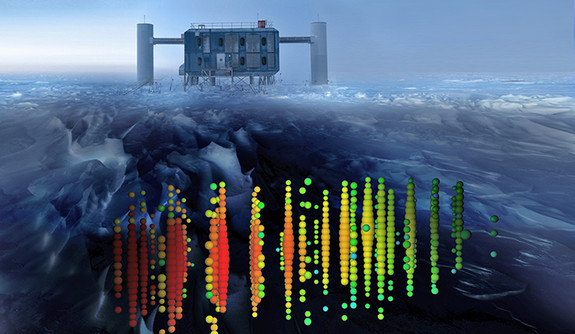Research topics
1) High-energy particle emission of radio loud active galactic nuclei
Astronomers study the universe through observational windows of the electromagnetic radiation, cosmic rays, neutrinos and gravitational waves. Extragalactic neutrinos, originating beyond the boundaries of our Galaxy can be observed from vast cosmological distances - these tiny particles are key messengers to reveal an unobstructed view of the universe where it is opaque to light.
Since the discovery of the cosmic high-energy neutrinos extensive studies have been carried out aiming at identifying their origins. The IceCube South Pole Neutrino Observatory has detected more than hundred cosmic high-energy neutrinos with energies between 100 TeV and 10 PeV, among millions of atmospheric neutrinos and hundreds of billions of cosmic-ray muons.

Active galactic nuclei (AGN) shine with the largest persistent luminosities in the universe. Their main engine is the central supermassive black hole (SMBH) that feeds on its environment, forming an accretion disk about itself. A pair of relativistic jets is launched from the immediate vicinity of a rotating SMBH, which is responsible for the radio-loudness of AGN. The most possible power source of the AGN jets is the rotation of the central SMBH, injecting enormous energy into them. In fact, AGN jets are the most powerful particle accelerators in the universe.

Although they accelerate cosmic-rays that produce the neutrinos and high-energy gamma-photons, neutrinos are the only high-energy particles we can observe from the distant corners of the universe. Therefore neutrinos are able to pinpoint such high-energy particle accelerators in the sky that would be otherwise hidden because the energetic cosmic rays and gamma-photons disappear in site and/or on their way to Earth. I study such objects with the tools of the neutrino, gamma and astronomy.
2) VLBI radio astronomy of radio loud active galaxy nuclei, signatures of merging supermassive black hole binaries
According to the accepted galaxy evolution models, galaxies gather their masses through a sequence of accretion and merger phases. As a result, million to billion Solar mass supermassive black holes formed at the centre of massive galaxies, and some of them might be members of binary systems due to the long time scale of the merger.
An accretion disk may form around the black hole due to the non- zero angular momentum of the infalling matter. As substantial amount of energy is released in the accretion disk due to its efficient mass-energy conversion, the compact centre of the galaxy becomes an active galactic nucleus (AGN).
Cosmological and galaxy evolution models render the peak of galaxy mergers to cosmological redshifts between two and three. Since at such distances it is not possible to spatially resolve sub-parsec separated binary systems, even with the astronomical techniques giving the finest angular resolutions, they can only be identified indirectly from measurements on the accretion disk and jets of either binary AGN, or active–passive pairs.
When a member of the supermassive black hole binary is radio-loud due to its relativistic jets (approximately 10 per cent of single AGN qualifies), a periodic jet structure might indicate, that the jet emitter black hole interacts gravitationally with another black hole. At present, radio interferometry (notably the technique of very long baseline interferometry, VLBI) provides the finest angular resolution images of AGN jets.
By analyzing multi-epoch VLBI data of galaxy jets and modelling them, I study the signatures of merging supermassive black hole binaries, that are otherwise hidden to other observational techniques, instruments. Entering the era of the direct observation of gravitational waves (GWs) finding such close pairs is particularly interesting to the source identification of GWs.
3) Galaxy rotation curves and dark matter models